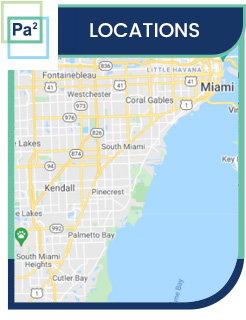What Triggers Pet Allergies?
At Piniella Asthma + Allergy in Coral Gables and Palmetto Bay, FL, board-certified Allergist Dr. Carlos Piniella MD helps patients understand and manage pet allergies. Common triggers include pet dander, saliva, and urine, which can cause a range of symptoms from sneezing and itchy eyes to more severe respiratory issues. Dr. Piniella offers expert diagnosis and personalized treatment plans to help you live comfortably with your pets. For more information, contact us today or schedule an online appointment. We have convenient locations to serve all our patients in Coral Gables FL and Palmetto Bay, FL.


Table of Contents:
What exactly are pet allergens and where are they found in pets?
Are there certain types of pets more likely to cause allergies than others?
Are there any seasonal variations in pet allergy triggers?
How long can pet allergens remain airborne and continue to trigger symptoms?
Many believe that they are allergic to an animal’s fur, or their feathers, however, this is not actually what causes pet allergies in people. Since animals have oils and dander in their fur this is what can cause allergies for patients when it comes to pets, specifically cats and dogs, especially since these animals will groom themselves with their tongues, and the saliva of these animals have enzymes that can cause reactions in those with allergies as well. The cause of your allergy to an animal can also vary from person to person, as you may not be allergic to the dander of the animal, but the enzymes present in the animal’s saliva are present on the fur. Animals also carry other allergens on in their hair, feathers, or fur, which can trigger allergies in people, as they do carry pollen, dust mites, or mold in their coats as well, which can lead to an allergic reaction. There is also a misconception about “hypo-allergenic” pets, as these animals may cause fewer allergies in some patients who are allergic to dander, but for those who are allergic to animal saliva, urine, or the aforementioned pollen, mold, or dust mites present in the hair, will still react to the presence of these animals.
Most common pet allergies are associated with pets that have fur, which is why many think of allergies to cats and dogs when thinking of pet allergies, but these allergies can also be caused by other animals that have fur such as hamsters or rabbits. Since the reaction to a pet allergy is based on what triggers the allergy, some patients may only be allergic to a certain animal because of the unique enzyme in the saliva, or they may be allergic to all pets because of the dander produced by pets. Since there is no truly “hypo-allergenic” bet with fur or feathers, those with allergies will be better off having animals such as fish or reptiles that do not create dander in the environment they live in.
Yes, there are seasonal variations in allergies for those who have pet-related allergy triggers, this is because of the changes that happen in the atmosphere. These reactions are associated with regular seasonal allergies, especially since at these times the patient may find that like clockwork every year around the same time their allergies flare up worse than at any other point in the year. Because during the spring and fall seasons, there is a higher presence of dust, mold, and pollen present outdoors, animals are more likely to contain these allergy triggers or a high concentration of these can get trapped in their fur, hair, or feathers, which can lead to an increase in allergies. Some patients will find during the winter when it is drier out that their allergies to animals worsen, and this can be because the dry air dries the animals’ skin more leading to a high production of dander during these months.
Those who have seasonal allergies are more likely to experience changes in their allergies to animals during the time that they experience seasonal allergies since there are more triggers present in the environment.
This can be highly debated, especially when it comes to the type of animal. However, the average amount of time that pet allergens will remain in an environment is around six months, regardless of the cleaning that happens in the space where the animal was present. This can also vary based on the amount of time that the animal was present in the space as well, as an animal that was only in a room for a few minutes may dissipate in around three months, whereas an animal that lived in a space for a year or longer, may take the aforementioned six months to dissipate or longer. There are also vacuums available on the market that are specifically designed for those with allergies and asthma, and these would be the best option for those looking to clean a space where an animal that triggers your allergies has been.
Trust Dr. Carlos Piniella MD and the team at Piniella Asthma + Allergy to provide comprehensive care for pet allergies. Our tailored treatment plans aim to alleviate symptoms and improve your quality of life, allowing you to enjoy the companionship of your pets without discomfort. Schedule a consultation in Coral Gables or Palmetto Bay, FL, today and take the first step towards effective allergy management. We serve patients from Coral Gables FL, Palmetto Bay FL, Westchester FL, Brownsville FL, Kendall FL, Pinecrest FL, Richmond West FL, Goulds FL, and the surrounding areas!

Additional Services You May Need
▸ Asthma
▸ Allergy Testing
▸ Food Allergies
▸ Immunotherapy
▸ Patch Testing
▸ Allergy Treatment
▸ Pediatric Asthma Specialist
▸ Pediatric Allergist
▸ Insect Bite Allergy
▸ Drug Allergy
▸ Seasonal Allergies
▸ Skin Allergy

Additional Services You May Need
▸ Asthma
▸ Allergy Testing
▸ Food Allergies
▸ Immunotherapy
▸ Patch Testing
▸ Allergy Treatment
▸ Pediatric Asthma Specialist
▸ Pediatric Allergist
▸ Insect Bite Allergy
▸ Drug Allergy
▸ Seasonal Allergies
▸ Skin Allergy


